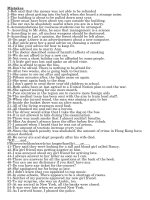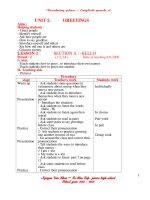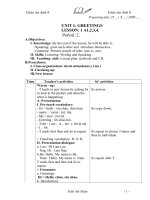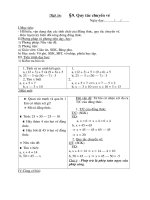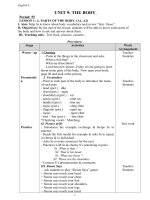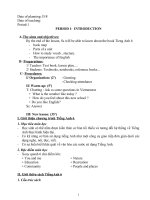giáo án tiếng anh 6 ky 2 mới
Bạn đang xem bản rút gọn của tài liệu. Xem và tải ngay bản đầy đủ của tài liệu tại đây (550.56 KB, 111 trang )
English 6
UNIT 9: THE BODY
Period: 55
LESSON 1: A. PARTS OF THE BODY. (A1, A2)
I. Aim: Help Ss to know about body vocabulary and review “that / those”.
II. Objectives: By the end of the lesson, students will be able to know some parts of the
body and how to ask and answer about them.
III. Teaching aids: Text book, pictures, cassette
Procedure:
Stage Activities Work
Arrangement
Warm - up
Presentatio
n
Practice
* Chatting
- Point at the things in the classroom and asks:
What is this/that?
What are these/those?
- Lead into new lesson: Today we are going to learn
about some parts of the body. Now open your book,
page 96 and look at the picture.
I. Vocabulary
- Point to each part of the body to introduce the name
of each part:
- head (pict.) : đầu
- chest (pict.) : ngực
- shoulder(s) (pict.) : vai
- arm(s) (pict.) : cánh tay
- hand(s) (pict.) : bàn tay
- leg(s) (pict.) : cẳng chân
- finger(s) (pict.) : ngón tay
- toe(s) : ngón chân
- foot – feet (pict.) : bàn chân
*Checking vocab. : Matching
II. Picture drill:
- Introduces the example exchange & Helps Ss to
practice.
- Reads the first model for example & asks Ss to repeat
in chorus & in individual.
- Asks Ss to make sentences for the next.
- Practices with Ss & checks S’s practicing in pairs .
S1: What is that ?
S2: That is his head.
S1: What are those ?
S2: Those are his shoulders
- Corrects S’s pronunciation & comments
III. Simon Says
Teacher-
Students
Teacher-
Students
Pair work
Teacher-
11
English 6
Further-
Practice
Homework:
- Ask students to play “Simon Says” game:
+ Simon says touch your head.
+ Simon says touch your chest.
+ Simon says touch your feet.
+ Simon says touch your shoulders.
+ Simon says touch your legs.
+ Simon says touch your head.
+ Simon says touch your left hand.
IV.Wordsquare:
- Introduces the word-square & asks Ss to work in
groups to find out the 14 hidden words.
– Asks Ss to give the words in two groups by circling
the words & put them into a present progressive
statement & write on the board.
- Corrects & Comments the game.
H E A D O X W T
A K L A C T F E
T R A V H A O W
F I N G E R O T
H D R I S M T O
Q E M A T S T E
O R R H A N D S
S H O U L D E R
- Learn the names of the parts of the body by heart.
- Prepare the next lesson : A3,4,5
Students
2 Teams
22
English 6
Period: 56: UNIT 9: THE BODY
LESSON 2: A. PARTS OF THE BODY. (A3, A4,A5)
I. Aim : Introduce to Ss some adjectives about people’s building
II. Objectives: By the end of the lesson, students will be able to describe people’s building.
III. Teaching aids: Text book, pictures, cassette
Procedure:
Stage Activities Work
Arrangement
Warm up
Presentation
*Networks:
Parts of the body
- Introduce new lesson.
I. Vocabulary :
- tall (pict.) :cao
- short(pict.): thấp
- fat (pict.) : mập, béo
- thin (pict.) : gầy
- heavy (pict.): nặng
- light (synonym) : nhẹ
* Check Vo: Slap the board
II. Model sentences:
- Ask students to fill in the gaps:
He tall
She short.
Teacher-
Students
Teacher-
Students
Teacher-
Students
33
English 6
Practice
Production
Homework
- Give out the structure:
* S + be + Adj.
(S + be + a/an + Adj + N)
Ex: She is short.
She is a short girl
III. Noughts and crosses:
Tall Big
Small Thin
Quiet Light
* S + be + Adj.
(S + be + a/an + Adj + N)
Ex: She is short.
She is a short girl.
IV. T/F repetition drill:
Which picture? Listen and choose the right picture.
- Ask Ss to fill in the suitable adjectives for each
person in the pictures A4.
Grid ( with answer key)
Fat? Tall? Short? Thin?
a) thin, tall (4)
b) short, fat (3)
c) tall, fat (2)
d) short, fat (1)
- Ask Ss to listen and put the pictures in correct
order.
V. Listen and read.
- Ask Ss to look at the picture about Chi and Tuan and
ask some questions about her/ him.
Ex: + What does she/ he do ?
+ How is her/ his build ?
- Introduce about Chi - a gymnast, Tuan – a weight
lifter
- Call some students to read about Chi and Tuan
before the class.
- Then ask students to close their book and retell about
Chi and Tuan.
- Give feedback.
- Learn vocabulary by heart.
- Prepare the next lesson: B1
2 Teams
Individual
work
Individual
work
44
English 6
UNIT 9: THE BODY
Period 57: Lesson 3: B: Faces (B1)
I. Aim: Introduce to Ss the face vocabulary and some more adjectives.
II. Objectives: By the end of the lesson, students will be able to know some parts of
people’s face and know how to describe people’s building and face.
II. Teaching aids: Text book, pictures, cassette
Procedure:
Stage Activities Work
Arrangement
55
English 6
Warm up
Presentation
Practice
Production
• Pelmanism:
fat tall heavy big noisy
thin short light small quiet
- Introduce new lesson: In our today lesson, we are
going to learn how to describe people’s face.
I. Vocabulary :
- eye (pict.) : mắt
- ear (pict.) : tai
- lip (pict.) : môi
- teeth (pict.) : răng
- hair (pict.) : tóc
- nose (pict.) : mũi
- mouth (pict.) : miệng
Adjectives
- round : tròn
- oval : hình trái xoan
- full : đầy đằn
- thin : mỏng, gầy
* Check Vo: Rub out & Remember
II. Presentation text:
- Introduces the six pictures on page 100 (a – f) & helps Ss
to practice.
- Checks S’s practicing in individual.
- introduce the model sentences.
- Corrects S’s pronunciation & comments.
• Model sentences:
a round face - an oval face
full lips - thin lips
long hair - short hair
III. Describe your friends:
- Ask Ss to look at their partners’ face and describe
- Practice in groups of 4. Look at their partners’face and
describe.
- Have Ss work in groups to play this game.
- Ask Ss to describe one of their classmates.
- Call on some Ss to describe in front of the class
IV. Word-square
A I R X F F
N E F A T I
E O Y F E N
2 Teams
Teacher-
Students
Teacher-
Students
Group work
2 Teams
66
English 6
Homework
A B S E E G
R T H E T E
M O U T H R
H E A V Y S
- Introduces the wordsquare & divides the class into two
groups & asks them to find out the 17 hidden words in the
square.
- Asks Ss to give the words.
- Corrects & comments.
* Answer key:
hair; fat; see; the; mouth; out; heavy.
ear; arm; near; toe; to; feet;
teeth; fingers.
nose; eye.
- Learn the new words by heart.
- Describe members in your family.
77
English 6
Period: 58 UNIT 9: THE BODY
LESSON 4: B. FACES. (B2, B3)
I. Aim: Introduce some colors to Ss and help Ss practice asking and answering
questions about colors.
II. Objective: By the end of the lesson, students will be able to know some colors and how
to ask and answer about colors.
III. Teaching aids: Text book, pictures, cassette
Procedure:
Stage Activities Work
Arrangement
Warm up
Presentation
* Jumbled Words:
yees = (eyes) cafe = (face)
hari = (hair) spli = (lips)
dreshouls = (shoulders) sone = (nose)
- Lead into new lesson: In our lesson, we will learn
some colors and also learn how to ask and answer about
things’ color.
I. Vocabulary :
- black (pict.) : màu đen
- white (pict.) : màu trắng
- gray/grey(BE) (pict.): màu xám
- red (pict.) : màu đỏ
- orange (pict.) : màu cam
- yellow (pict.) : màu vàng
- green (pict.) : màu xanh lá cây
- blue (pict.) : màu xanh da trời
- brown (pict.) : màu nâu
- purple (pict.) : màu tím
* Check Vo : Matching.
II. Make sentences: (with answer key)
- Introduces the requirements & the table then asks Ss to
make sentences:
• She has brown hair.
• She has green eyes. Etc…
She has eyes hair
Black ()
Brown () ()
Grey () ()
2 Teams
Teacher-
Students
Teacher-
Students
88
English 6
Practice
Homework
White ()
Red ()
Yellow
Blue ()
Green ()
III. Model Sentences:
Hoa: I have a new doll.
Mai: What color is her hair?
Hoa: It’s black.
Mai: What color are her eyes?
Hoa: They are brown
- Present the model sentences:
What color is + N (số ít)?
are + N(số nhiều)?
It is + color.
They are
Use: dùng để hỏi màu sắc của các vật.
IV. Picture drill B- 3 P. 101
- Ask and answer about the color of four dolls.
- Ask Ss to practice in front of the class.
Example exchanges
A: What color is her hair?
B: It’s [ black]
A: What color are her eyes?
B: They’re [ brown]
- Let ss work in opened pairs and closed pairs.
- Give feedbacks.
- Learn the words of colors by heart.
Teacher-
Students
Pair work
99
English 6
- Prepare the next lesson B 4, 5, 6
Period: 59 UNIT 9: THE BODY
LESSON 5: B. FACES. (B4, B5, B6)
I. Aim: Reading the text about Miss Chi for details and listen to people’s
descriptions.
II.Objective: By the end of the lesson students will be able to under the text and further
practice in body vocabulary to describe people
III. Teaching aids: Text book, pictures, cassette
Procedure:
Stage Activities Work
Arrangement
Warm up
Pre-reading
Play “ Slap the board”
Mouth, Lips, Eyes, Hair, Nose, Teeth, Ear.
- Give feedbacks.
I. Put the words in correct order.
- Let students work in pairs to make the meaningful
sentences by ordering.
a.eyes / Lan/ brown /has
b.thin / has / she / lips
c.face / he / oval / has /an.
2 Teams
Pair work
1010
English 6
While-
reading
Post-Reading
d. teeth / she / white / has.
* Key:
a. Lan has brown eyes.
b. She has thin líp.
c. He has an oval face.
d. She has white teeth .
II.Gap filling prediction:
Mrs Chi is (1) and thin. She has a (2) face, (3)
, (4) hair, (5) eyes, a (6) nose, (7)
lips and smal; (8) teeth.
-T sticks the picture.
-Ss look at the picture and have a guess and fill words in
the blanks.
-Give feedback.
* Checking:
-T reads the text, Ss repeat.
-Students check their prediction.
Answer key (gap fill)
1.tall 2.round 3.long 4.black
5. brown 6. small 7.thin 8.white
III. Comprehension questions: Lucky numbers
- Ask ss answer the questions on page 102 about Miss
Lien.
- Then let them play the game: Lucky numbers
* Keys:
1.Miss Chi’s hair is long.
2. Her eyes are brown.
3.Her hair is black
4. Lucky number
5. Her nose is small.
6. Her lips are full.
7. Lucky number
8. Lucky number
- Get ss work in pairs to practice asking and answering
the questions.
IV.Listen.(B5/ p 102)
- Set the scene:
- Ask Ss to describe picture by picture.
- Have Ss listen sentence by sentence, then write the
letter of the pictures.
- Have them compare their answer with their partner.
- Ask Ss to listen to again once then give out the correct
answer.
Teacher-
Students
Individual work
2 Teams
Pair work
Teacher-
Students
1111
English 6
Homework
1:c 2:a 3:d 4:b
- Prepare the next lesson.
UNIT 10: STAYING HEALTHY
Period: 60: LESSON 1: A. HOW DO YOU FEEL? (A1, A2, A5)
I. Aim: Introduce people’s feelings vocabulary to Ss and help Ss practice asking and
answering the questions about their feelings.
1212
English 6
II. Objectives: By the end of the lesson, students will be able to talk about their feelings
and ask and answer about other’s feelings.
III. Teaching aids: Text book, pictures, cassette
Procedure:
Stage Activities Work
Arrangement
Warm up
Presentatio
n
Practice
• Find the words
Give the opposite meaning words:
1) Thin # (fat)
2) short # (long)
3) big # (small)
4) heavy # (light)
5) strong # (weak)
6) young # (old)
- Introduce the content of the lesson: We are going
to learn about people’s feeling and the way of asking
and anwering about feelings.
I. Vocabulary :
-hungry (adj) (mime)
-thirsty (adj) (mime)
-full (adj) (picture)
-hot (adj) (picture)
-cold (adj) (picture)
-tired (adj) (picture)
-to feel (trans)
*Checking : Matching
II. Present the model sentences.
- Teacher models the pictures on page 104, then ask Ss to
repeat chorally and individually.
- Teacher gives an example and elicit Ss:
Ex: How do you feel?
I’m hungry.
- Elicit ss by an example and give them the new
structures:
*Form: How do / does + S + feel?
S + tobe / feel + Feelings
* Use: dung để hỏi và trả lời về cảm giác của ai đó.
III.Words Cue Drill
- Ask Ss to practice in pairs asking about feelings , use
the cues given below.
hungry thirsty hot
cold tired full
2 Teams
Teacher-
Students
Teacher-
Students
Pair work
1313
English 6
Production
Homework
- Call some pairs practice in front of the class.
Ex: S1: How do you feel?
S2: I’m hungry.
IV. Picture Drill.
- Give Cued words A1- P. 104 - a –> f
- Ask Ss to practice asking and answering in pairs.
- Call some Ss to practice in front of the class.
Ex: S1: How does he feel?
S2: He is hungry.
- Give feedbacks.
V. Listen and match the names with the right pictures.
* Let ss describe the pictures on page 106 first then listen
to the tape and match the names with the right pictures.
* Answer:
Phuong- b
Nhan- a
Ba- f
Huong- d
- Learn vocabulary and the model sentences by heart.
- Prepare the next lesson A3, 4, 6, 7.
Pair work
Individual work
1414
English 6
UNIT 10: STAYINHEALTHY
Period 61: LESSON 2: A. HOW DO YOU FEEL? (A3, 4, 6, 7)
I. Aim: Introduce polite offers & requests to Ss and help Ss practice asking and answering
the questions about polite offers & requests.
II. Objectives: By the end of the lesson, students will be able to talk about their polite
offers & requests and ask and answer about other’s polite offers & requests.
III. Teaching aids: Text book, pictures, cassette
Procedure:
Stage Activities Students’
activities
Warm up
Pre-
Reading
* Make sentences with “How feel?”
1) Mai/ tired
2) Nhi/ thirsty
3) You/ hungry
4) Huy and Vinh/ hungry
5) Lan’s mother/ cold
- Introduce new lesson: We are going to learn how to
ask and answer about people’s demand and desire by using
the structures: What would you like? Or: Would you like?
I. New words:
-an orange (pict)
-juice (n) (trans)
-orange juice (n) (trans)
-a drink (examp)
-noodles (n) (trans)
-would like (‘d like) = want (v) (trans)
-would not = wouldn’t
* Checking: What and where.
*Note: Some + Uncountable nouns.
Countable
II.Predict Dialogue
Nam: How do you feel?
Whole class
Teacher-
Students
Pair work
1515
English 6
While –
reading
Lan: I’m and
Nam: What would you like?
Lan: I would like some What about you?
Nam: I’m I’d like some
- Introduces the open dialogue & asks Ss to work in pairs
to predict the suitable words to fill in the gaps to complete
the dialogue.
- Asks Ss to give their prediction.
- Comments their prediction.
* Checking:
Introduces & Helps Ss to read the dialogue between Nam
& Lan & get the details.
- Ask Ss to check their prediction.
- Corrects.
III Matching:
- Introduce the poster & ask Ss to read the dialogue again
& match the key words to the people.
- Ask Ss to compare & give the keys.
Lan Nam Ba
hot
x
thirsty
tired
full
hungry
noodles
a drink
orange juice
To sit down
- Call some Ss to report their work in front of the class.
IV. Grammar:
- Elicit and give ss the new structure:
Would you like ?
-Hỏi ai muốn điều gì 1 cách lịch sự.
What would you like? = what do you want?
-Đưa ra lời mời lịch sự
Ex: Would you like a cup of tea?
V. Ask and answer about Nam, Lan and Ba. (A4/p 106)
- Ask Ss to use the above information to ask and answer
Individual work
Teacher-
Students
Pair work
1616
English 6
Post-
Reading
Homework
about the three people’s feeling, demand and desire.
- Call on some pairs to practice in front of the class .
S1: How does Lan feel?
S2;She is thirsty
S1: What would she like?
S2: She’d like some orange juice
VI. Listen and repeat. Then practice the dialogue with a
partner.
- Present the model sentence:
What’s the matter with ?
= What’s wrong with ?
- Present the text A6- P. 106.
- Ask Ss to practice reading the dialogue in pairs in front
of the class.
- Ask Ss to use these words and make a new dialogue
with a partner.
a) hot/ cold drink
b) hungry/ noodles
c) thirsty/ drink
- Call some pairs to practice in front of the class.
- Learn the new structures and new words by heart.
Pair work
UNIT 10: STAYING HEALTHY
Period: 62: LESSON 3: B. FOOD AND DRINK (B1, B2, B3)
I. Aim: Introduce to Ss food and drink vocabulary and “some and any”.
II. Objectives: By the end of the lesson, students will be able to know names of some foods
and drinks and use “some” or “any” fluently.
III. Teaching aids: Text book, pictures, cassette
Procedure:
Stage Activities Work
Arrangement
Warm up
Presentatio
• Make questions with “What would like?”
1. I want some orange juice.
2. They’d like some water.
3. He wants some cold drink.
4. My mother’d like noodles.
- In our lesson we will learn some kinds of food and
drink.
I. New words:
Teacher-
Students
1717
English 6
n -an apple ( realia/pict)
-rice (pict)
-water (realia/ pict)
-food (examp)
-milk (trans)
-meat (pict)
-an orange *(pict)
-a banana (pict)
-vegetables ( pict / example)
* Checking Vocab. : Matching
* Notes: The usage of “some”, “a”, “an”
- some + uncountable nouns
countable nouns
- a + one countable noun beginning with a
consonant.
- an + one countable noun beginning with a vowel.
II.Asking and Answering:
- Ask Ss to look at the pictures on page 108, work in
pairs,then practice asking and answering.
S1: What would you like?
S2:I’d like an apple. What would you like?
S2: I’d like some milk.
III. Presentation dialogue: B2-P109
- Introduces & Helps Ss to listen to the dialogue &
introduces the model sentence.
- Helps Ss to practice the dialogue in groups & in pairs.
- Corrects S’s pronunciation & comments.
* Ask and answer:
- After practice the dialogue, ask ss to work in pairs and
answer the questions:
-What’s for lunch? There are some meat and rice and
some fruit.
-What’s there to drink? There is some water.
- Elicit and give students the new structure:
*Model sentences
Ex:There’s some rice/ Is there any rice?
There isn’t any rice.
Note:
-Some: dung trong câu khẳng định.
-Any: dung trong câu phủ định và nghi vấn.
Ex: Are there any bananas?
Yes, there are some bananas.
Teacher-
Students
Pair work
Pair work
Pair work
Teacher-
Students
1818
English 6
Practice
Homework
IV. Picture drill (B3)
-Is there any ? Yes, there is some
No, there isn’t any
-Are there any ?/Yes, there are some
No, there aren’t any
- Ask Ss to practice asking and answering about the
pictures B1- P. 109 as the examples:
Is there any ? Yes. There is some
No. There isn’t any
Are there any ? Yes. There are some
No. There are not any
- Ask Ss to practice in front of the class.
- Learn the new words by heart.
- Do exercise: Write true sentences about your
kitchen, using “there is/ there isn’t any ” And “There
are/ There aren’t any ”
Pair work
UNIT 10: STAYING HEALTHY
Period: 63: LESSON 4: B. FOOD AND DRINK (B4, B5)
I. Aims and Objectives: By the end of the lesson, students will be able to know names of
some foods and drinks and use the structure: “What would you like?” and “I’d like”
fluently.
II. Teaching aids: Text book, pictures, cassette
1919
English 6
Stage Activities Work
Arrangement
2020
English 6
Warm up
Presentation
Practice
Production
• Networks:
- Introduce new lesson: In our today lesson, we will
learn some kinds of food and drink.
I. Vocabulary:
- menu ( n ): ( Translation )
- fish ( n ): ( picture )
- chicken ( n ): ( picture )
- bread ( n ): ( picture )
* Checking vocab. : Rub out and remember.
II. Make the similar dialogue
- Ask Ss to use the menu in B4 and the pictures a) – f) in
B5, asking and answering about food and drink that they
like.
- Call some Ss to practice in front of the class.
Ex: S1: I’m hungry. I’d like some chicken and rice.
What would you like?
S2: I’m not hungry, but I’m thirsty. I’d like some
orange juice.
III. Listen and match:
- Ask ss to look at the pictures on page 111, then guess
what Nhan, Tuan, Huong and Mai would like.
- Call on some pairs to give their answer.
* Checking
- Play the tape & ask Ss to listen & match the names of
the people with what they would like.
- Asks Ss to compare & giving their matching.
Nhan: c, f Tuan: a, d
Huong: e, g Mai: b, h
IV. Talk about Nhan, Huong, Tuan and Mai by asking
and answering bout them
Ex: What would Nhan like?
He’d like some chicken and some rice.
- Let ss work in pairs, then ask and answer.
- Call on some pairs to practice in front of class.
2Teams
Teacher-
Students
Pair work
Individual work
Pair work
Drink
Food
2121
English 6
Homework
- Do exercises: 3, 4- P. 90 (in workbook)
- Learn vocabulary by heart.
- Prepare the next lesson.
Procedure:
Period: 64: UNIT 10: STAYING HEALTHY
2222
English 6
LESSON 5: C. MY FAVORITE FOOD (C1, C2, C3, C4)
I. Aims and Objectives: By the end of the lesson, students will be able to talk about
their favorite foods and drinks and use the structure: “what favorite food/ drink and
do you like” fluently.
II. Teaching aids: Text book, pictures, cassette
Procedure:
Stage Activities Work
Arrangement
Warm up
Presentatio
n
Practice
* Fill in the blanks with a, an, some or any:
1) There is not milk in the jar.
2) No. There are not noodles.
3) I have orange.
4) Do you have meat?
5) I am hungry. I would like chicken.
- Introduce new lesson: In this lesson we will learn
some kinds of vegetables and the questions about people’s
hobby.
I. New words:
- favorite ( adj ): ( translation )
- carrot ( n ): ( picture / real object )
- tomato ( n ): ( picture / real object )
- lettuce ( n ): ( picture / real object )
- potato ( n ): ( picture / real object )
- bean ( n ): ( picture / real object )
- pea ( n ): ( picture / real object )
- cabbage ( n ): ( picture / real object )
- onion ( n ): ( picture / real object )
* Checking Vocab. : Matching
II. Picture drill: C1-P112
- Introduces the example exchange & Helps Ss to practice.
- Reads the first modal for example & asks Ss to repeat in
chorus & in individual.
- Asks Ss to make sentences for the next.
- Practices with Ss & checks S’s practicing in pairs.
S1: What are these ?
S2: They are beans. What are those?
S1: They are carrots.
III. Rub out and remember dialogue
Teacher-
Students
Teacher-
Students
Teacher-
Students
Pair work
2323
English 6
Presentation
Practice
Production
* Introduces the dialogue by giving the symbols for the
words & Helps Ss to listen to the dialogue.
- Helps Ss to read the dialogue in chorus to remember.
- Helps Ss to practice the dialogue in groups & in pairs.
- Introduces the model sentence.
* Model sentences:
+ Do you like vegetables?
Yes, I do.
No, I don’t.
+ Would you like some vegetable?
Yes, please. / Yes, I would.
No, thank you. / No, I would not.
IV. Listen and repeat
- lemonade ( n ): ( picture & explaination )
- lemon ( n ): ( real object )
- iced ( adj ): ( explaination & translation )
- tea ( n ): ( example )
- coffee ( n ): ( example )
- soda ( n ): ( translation )
- T sets the situation and uses pictures to introduces new
words.
- Ask ss to guess the meaning and listen and repeat. Then
practice.
T controls and corrects their mistakes
V.Make up the dialogues:
- Introduce the dialogue in C 4.
- Ask Ss to practice reading the dialogue in pairs
- Call some pairs to practice in front of the class.
- Let Ss make their own dialogue using the pictures in C3
- Give feedbacks
VI. Take survey
- Tell Ss to ask thier friends then fill in the table:
name Likes doesn’t like
Nam
Thuy
Chicken/orange Fish
Teacher
Students
Teacher-
Students
Teacher-
Students
Pair work
Whole class
2424
English 6
Homework
- Call some Ss to report in front of the class.
- Give feedbacks.
- Learn by heart and distinguish two structures:
“Would you like ?” and “Do you like ?”
Period: 65: UNIT 11: WHAT DO YOU EAT?
Lesson 1 : A: AT THE STORE. (A1)
I. Aims and Objectives: By the end of the lesson, students will be able to know the
ways of communication when buying things everyday and know how to talk about
the quantity and weight.
II. Teaching aids: Text book, pictures, cassette
Procedure:
Stage Activities Work
Arrangement
Warm up
Presentatio
n
Teacher hangs the picture to introduces new lesson and
asks students to guess the situation.
I. New words:
- storekeeper ( n ): ( picture )
Teacher-
Students
Teacher-
Students
2525

